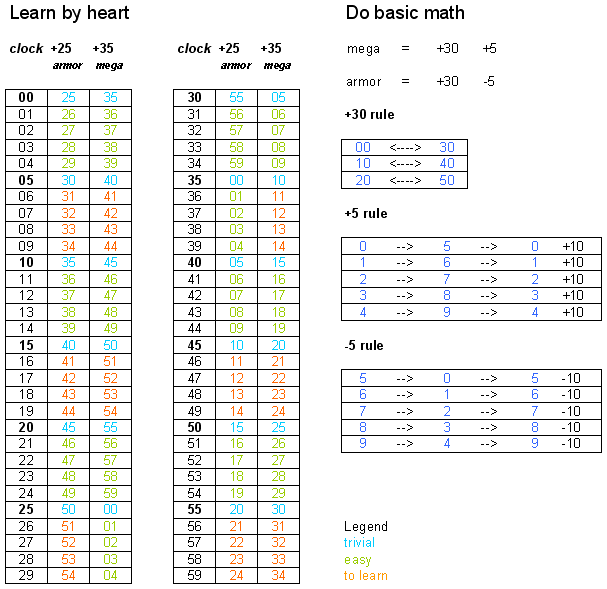Reduced to its core, item timing involves the following three steps.
1. See/Hear the item pickup
Seeing the item pickup usually takes place in one of the following scenarios:
1.1. Clean pickup. You take it.
2. Compute next spawn time
A common opinion is to think that we do computations by applying some sort of formula or reasoning, and that to be fast you need a clever algorithm. This is indeed true when we have to operate with big numbers or do non trivial operations. However, remember the primary school and the time spent learning the multiplication tables from 1 to 10. What we were doing was to fix in our memory the results of some basic computations that are useful in real life. The point back then (as well as here now) was that the fastest way to compute something is to already know the result.
So if you want to learn timing the best way, learn all computations by heart. A few things to notice:
2.1. Clock Math
2.3. Do basic math

2.4. Pairs trick
3. Incorporate this knowledge into your plan
3.1. Easy to forget
The main problem with timing is that itís easy to forget about it. This has two consequences, both equally bad:
Lower tier players tend to have problem with the former, while better players have to deal mainly with the latter, which may be induced by the opponentís delays. If you still struggle to do timing, you probably are low/mid tier.
3.2. Planning helps
To attack the first problem, one suggestion is to invest more efforts into connecting your duelling plans with the timing. The reasoning is the following:
If you try and remember the timing of an item for the sake of it, you may find that ok for a minute or two, but then after a while your brain may go blank. Instead, you can try to strengthen your memory by associating your plans with the timing knowledge you just acquired. To exemplify: it is much easier to remember that red is at 2:47, if you think this gives you the ten seconds you need to go grab rocket, pickup the two health bubbles, and take the jump pad to go to the top floor to be in position to challenge the next red spawn, rather than just knowing that red is at 2:47 and period. Even if you then forget about the perfect time, you still did the right move, and are in a good position.
If you find it hard to do timing in a map, try to consider the available paths the map offers, how much time it takes to travel from item to item, so that the next time you play you already have a plan before even taking the items. The more you can plan in advance, the easier it is while playing.
3.3. Things to remember
Even when you have a plan, you can still do wrong. There are two problems:
1. See/Hear the item pickup
Seeing the item pickup usually takes place in one of the following scenarios:
1.1. Clean pickup. You take it.
This is indeed the simplest case. The only thing to make sure is to watch the clock when picking the item up. Sometimes you have enough time to pick the item at a convenient rounded value, so that timing is easy, or delay the item to avoid multiple items to spawn at the same time.1.2. Clean pickup. The opponent takes it.
Sometimes you are out of map control, but want to get in sync with the item timings. You will then sneak to a location that allows you to see/hear the item pickup. Usually the hard part here is to avoid the contact with the enemy, and in terms of timing this is almost as easy as 1.1.1.3. Dirty pickup. You take it.
This is the case where the opponent doesnít want to challenge for the item yet, but knows your intention and will show up to damage you, spamming from mid/long range. What is difficult here is that you will have to hide/dodge to avoid getting hit, but still you have to watch the clock to know the pickup. One tip can be to simply take the item, then hide, and then watch the clock and subtract 1 or 2 seconds (it does not take much more than that to hide).1.4. Dirty pickup. The opponent takes it.
This is similar to 1.3. with the difference that you may sometimes not see the pickup because you are hiding/dodging return fire. If you are in ears range, the pickup is easy to notice. If you are far away, try to make sure you see that the item was picked up.1.5. Close fight where both you and the opponent want to pick up.
This scenario is what I find the most difficult. The fight for the item may take most of your concentration, and after the battle you may have to quickly think what to do next. It is easy to forget the timing. The best you can do is to kill your opponent before the pickup, but if you have to pick it at mid-fight, spend a split second to watch the clock. If you die, you can wait 5 seconds before spawning to see/hear when the item is picked up.
2. Compute next spawn time
A common opinion is to think that we do computations by applying some sort of formula or reasoning, and that to be fast you need a clever algorithm. This is indeed true when we have to operate with big numbers or do non trivial operations. However, remember the primary school and the time spent learning the multiplication tables from 1 to 10. What we were doing was to fix in our memory the results of some basic computations that are useful in real life. The point back then (as well as here now) was that the fastest way to compute something is to already know the result.
So if you want to learn timing the best way, learn all computations by heart. A few things to notice:
2.1. Clock Math
In a modulo 60 ring (a clock), +35 is equal to -25, and +25 is equal to -35. This means that there is no difference between a clock that counts up or down, since you can simply invert your timing practice for mega and armors and change the clock direction. However most people use an ascending clock (so if you play in teams itís easier if everybody uses the same), and quake live is currently bugged (the descending clock becomes ascending in overtime), so if are not used to anything yet, just use the clock counting up.2.2. Lean by heart
The number of computations to learn by heart is not as big as one may think. There are some computations that are trivial, and some are quite easy to remember. Then there are some that require a bit of learning effort. I made a table (see below) with all numbers, coloring them based on how easy they are to remember for me.
Namad wrote a nice simple app that may help you training: http://visualhud.pk69.com/timer.html
Evol made a similar app, that displays the result automatically after a given period of time. http://deadmen.us/quake-timers.html
2.3. Do basic math
If you want to reduce the memory usage (and increase the algorithm complexity) you can derive a math scheme that suits you. Here I present one which is easy to remember, and not that hard to compute, but you may have better solutions that you find more intuitive. Remember though, no matter how clever your algorithm is, it will not be better than just knowing the numbers.
2.4. Pairs trick
Sometimes it is useful to use the pairs trick. On the clock 35 + 35 = +10 and 25 + 25 = -10, so if you take mega at 12 and know the next is 47, you can predict that the later megas will be 22,57, then 32,07 and so on. Same for red but with -10.
3. Incorporate this knowledge into your plan
3.1. Easy to forget
The main problem with timing is that itís easy to forget about it. This has two consequences, both equally bad:
1) You may not show up to take/challenge/spam an item
2) You may show up at the wrong time.
Lower tier players tend to have problem with the former, while better players have to deal mainly with the latter, which may be induced by the opponentís delays. If you still struggle to do timing, you probably are low/mid tier.
3.2. Planning helps
To attack the first problem, one suggestion is to invest more efforts into connecting your duelling plans with the timing. The reasoning is the following:
If you try and remember the timing of an item for the sake of it, you may find that ok for a minute or two, but then after a while your brain may go blank. Instead, you can try to strengthen your memory by associating your plans with the timing knowledge you just acquired. To exemplify: it is much easier to remember that red is at 2:47, if you think this gives you the ten seconds you need to go grab rocket, pickup the two health bubbles, and take the jump pad to go to the top floor to be in position to challenge the next red spawn, rather than just knowing that red is at 2:47 and period. Even if you then forget about the perfect time, you still did the right move, and are in a good position.
If you find it hard to do timing in a map, try to consider the available paths the map offers, how much time it takes to travel from item to item, so that the next time you play you already have a plan before even taking the items. The more you can plan in advance, the easier it is while playing.
3.3. Things to remember
Even when you have a plan, you can still do wrong. There are two problems:
1) Remember the actual numbers. This requires concentration. In his bible, Chance suggests to repeat the numbers either in your head, or by saying them. Saying things loud has the advantage that more parts of your brain have to process the numbers, and your auditive memory may kick in as well.
2) Remember to what items those number refer. This is where the plan should help a lot. For a bunch of armors, this may be as simple as remembering a sequence of pickups. For armors and mega, this is more complex, as the order in which you pick them up changes.

